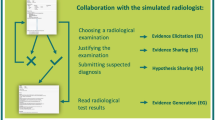Abstract
Today a great many medical schools have turned to a problem-based learning (PBL) approach to teaching as an alternative to traditional didactic medical education to teach clinical-reasoning skills at the early stages of medical education. While PBL has many strengths, effective PBL tutoring is time-intensive and requires the tutor to provide a high degree of personal attention to the students, which is difficult in the current academic environment of increasing demands on faculty time. This paper describes the student modeling approach used in the COMET intelligent tutoring system for collaborative medical PBL. To generate appropriate tutorial actions, COMET uses a model of each student’s clinical reasoning for the problem domain. In addition, since problem solving in group PBL is a collaborative process, COMET uses a group model that enables it to do things like focus the group discussion, promote collaboration, and suggest peer helpers. Bayesian networks are used to model individual student knowledge and activity, as well as that of the group. The validity of the modeling approach has been tested with student models in the areas of head injury, stroke, and heart attack. Receiver operating characteristic (ROC) curve analysis shows that the models are highly accurate in predicting individual student actions. Comparison with human tutors shows that the focus of group activity determined by the model agrees with that suggested by the majority of the human tutors with a high degree of statistical agreement (McNemar test, p = 0.774, Kappa = 0.823).
Similar content being viewed by others
References
Anderson J.R. (1993). Problem solving and learning’. Am. Psychol. 48(1): 35–44
Anderson J.R., Jeffries R. (1985). Novice LISP Errors: Undetected losses of information from working memory. Human Comp. Interact. 1(2): 107–131
Arocha J.F., Patel V.L., Patel Y.C. (1993). Hypothesis generation and the coordination of theory and evidence in novice diagnostic reasoning. Med. Decis. Making 13(3), 198–211
Barrows H.S. (1986).A taxonomy of problem-based learning method s. Med. Educ. 20(6): 481–486
Barrows H.S. (1996). Problem-based learning in medicine and beyond: a brief overview. In: Wilkerson L., Gislaers W.H (eds). Bringing Problem-based Learning to Higher Education: Theory and Practice. Jossey-Bass, San Francisco, CA pp 3–12
Barrows H.S., Tamblyn R.M. (1980). Problem-based Learning: an Approach to Medical Education. Springer, New York
Bonar J., Cunningham R. (1988). Bridge: An intelligent tutor for thinking about programming. In: Self J. (eds). Artificial Intelligence and Human Learning: Intelligent Computer-aided Instruction. Chapman and Hall, London, pp. 391–409
Bradley A.P. (1995). The use of area under ROC curve in the evaluation oflearning algorithms. Pattern Recognit. 30(6): 1145–1159
Chi M.T.H., Siler S.A., Jeong H., Yamauchi T., Hausmann R.G. (2001). Learning from human tutoring. Cogn. Sci. 25(4): 471–533
Clancey W.J. (1983). Guidon. J. Comp. Based Instruct. 10(1): 8–14
Conati C., Gertner A., VanLehn K. (2002). Using Bayesian networks to manage uncertainty in student modeling. User Model. User-Adapt. Interact. 12(4): 371–417
Corbett A.T., Anderson J.R. (1995). Knowledge tracing: modeling the acquisition of procedural knowledge. User Model. User-Adapt. Interact. 4(4): 253–278
Cote, R.A., Rothwel, D.J., Beckett, R.S., Palotay, J.L. (eds.) SNOMED International: The Systematized Nomenclature of Human and Veterinary Medicine. College of American Pathologists Northfield (1993)
Crowley, R., Medvedeva, O. A general architecture for intelligent tutoring of diagnostic classification problem solving. In: American Medical Informatics Association Symposium, pp. 185–189. Washington, D.C. (2003)
Das M., Mpofu D.F.S., Hasan M.Y., Stewart T.S. (2002). Student perceptions of tutor skills in problem-based learning tutorials. Med. Educ. 36(3): 272–278
Dawson B., Trapp R.G. (eds.) (2001). Basic and Clinical Biostatistics. McGraw-Hill, New York
Dolmans D.H., Wolfhagen I.H., Scherpbier A.J. Vleuten C.P. (2001). Relationship of tutors’ group-dynamics skills to their performance rating in problem-based learning. Acad. Med. 76(5): 473–476
Elstein A.L., Shulman L.S., Sprafka S.A. (eds) (1978). Medical Problem Solving – an Analysis of Clinical Reasoning. Harvard University Press, M.A.
Feltovich P.J., Barrows H.S. (1984). Issues of generality in medical problem solving. In: Schmidt H.G., De Volder M.L. (eds). Tutorials in Problem-based Learning: A New Direction in Teaching the Health Professions. Van Gorcum, The Netherlands, pp. 128–142
Franz T.M., Larson J.R. (2002). The impact of experts on information sharing during group discussion. Small Group Res. 33(4): 383–411
Grant J., Marsden P. (1988). Primary knowledge, medical education and consultant expertise. Med. Educ. 22(3): 173–179
Hanley J., McNeil B. (1983). A method of comparing the areas under receiver operating characteristic curves derived from the same case. Radiology 148(3): 839–43
Inaba, A., Mizoguchi, R.: Learners roles and predictable educational benefits in collaborative learning: an ontological approach to support design and analysis of CSCL. In: Seventh International Conference on Intelligent Tutoring Systems, pp. 285–294. Alagoas, Brazil (2004)
Jameson, A., Baldes, S., Kleinbauer, T.: Generative models of group members as support for group collaboration. Ninth International Conference on User Modeling, pp. 1–14. Johnstown, Pennsylvania (2003)
Kahn C.E. Jr., Roberts L.M., Shaffer K.A., Haddawy P. (1997). Construction of a Bayesian network for mammographic diagnosis of breast cancer. Comp. Biol. Medi. 27(1): 19–29
Koschmann T., Kelson A., Feltovich P., Barrows H.S. (1996). Computer-supported problem-based learning: a principled approach to the use of computers in collaborative learning. In: Koschmann T. (eds) CSCL: Theory and Practice of an Emerging Paradigm. Erlbaum, Mahwah, NJ pp. 83–124
Larson J.R., Jr., Christensen C. (1993). Groups as problem-solving units: toward a new meaning of social cognition. Br. J. Soc. Psychol. 32(2): 5–30
Lauritzen S.L. (1995). The EM-algorithm for graphical association models with missing data. Computat. Stat. Data Anal. 19(2): 191–201
Levine J.M., Moreland R.L.: Small groups In: Gilbert, D., Fiske, S., Lindzey, G. (eds.) The Handbook of Social Psychology, pp. 415–469. McGraw-Hill, Boston, MA
Levine J.M., Moreland R.L. (2004). Collaboration: The social context of theory development. Pers. Soc. Psychol. Rev. 8(2): 164–172
Lock, Z., Kudenko, D.: Multi-component user models of team members. In: Ninth International Conference on User Modeling, pp. 25–34. Johnstown, Pennsylvania
Mclaren, B.M., Walker, E., Harrer, A., Bollen, L., Sewall, J.: Creating cognitive tutors for collaborative learning: steps toward realization. In this issue (2006)
Mahling, D.E., Sorrows, B.B., Skogseid, I.: A Collaborative environment for semi-structured medical problem based learning. In: First International Conference on Computer-Supported Collaborative Learning, pp. 218–225 Bloomington, IIN (1995)
Martens, A., Bernauer, J., Illmann, T.: Seitz, A.: A. Docs ’n Drugs – The virtual polyclinic: an intelligent tutoring system for web-based and case-oriented training in medicine. In: American Medical Informatics Association Fall Symposium, pp. 433–437. Washington, DC (2001)
Martha, W. et al.: CIRCSIM-tutor: an intelligent tutoring system using natural language dialogue. In: Twelfth Midwest AI and Cognitive Science Conference, pp. 16–23. Oxford, OH (2001)
Masthoff J. (2004). Group modeling: selecting a sequence of television items to suit a group of viewers. User Model. User-Adapt. Interact. 14(1): 37–85
Milliken F.J., Bartel C.A., Kurtzberg T.R. (2003). Diversity and creativity in work groups: a dynamic perspective on the affective and cognitive processes that link diversity and performance. In: Paulus P.B., Nijstad B.A. (eds). Group Creativity: Innovation through Collaboration. Oxford University Press, New York, pp. 32–62
Mitrovic, A.: Experiences in implementing constraint-based modeling in SQL-tutor. In: Fourth International Conference in Intelligent Tutoring Systems, pp. 414–423 San Antonio, TX (1998)
Moore K.L., Dalley A.F. (eds) (1999) Clinically oriented anatomy Lippincott. William & Willkins, Philadelphia
Nathan M.J., Kintsch W., Young E. (1992). A theory of algebra-word-problem comprehension and its implications for the design of learning environments. Cognition and Instruction 9(4): 329–389
Neale M.A., Mannix E.A., Gruenfeld D.H. (eds.) (1998) Research on managing groups and teams: Composition. JAI, Greenwich CT
Newble, D., Norman, G., Vleuten, C.: Assessing clinical reasoning. In: Jones, J.H.M. (ed.): Clinical Reasoning in the Health Professions, pp. 156–168. Butterworth-Heinemann, Oxford (2000)
Nijstad B.A., Diehl M., Stroebe W. (2003). Cognitive stimulation and interference in idea-generating groups. In: Paulus P.B., Nijstad B.A. (eds). Group Creativity: Innovation through Collaboration. Oxford University Press, New York, pp. 137–159
Read, T., Barros, B., Bárcena, E., Pancorbo, J.: Coalescing individual and collaborative learning to model user linguistic competences. In this issue (2006)
Reusser K. (1993). Tutoring systems and pedagogical theory: Representational tools for understanding, planning, and reflection in problem solving. In: Lajoie S.P., Derry S.J. (eds). Computers as Cognitive Tools. Lawrence Erlbaum Associates, Hillsdale, NJ, pp. 143–177
Schmidt H.G., Norman G.R., Boshuizen H.P.A. (1990). A cognitive perspective on medical expertise: theory and implications. Acad. Med. 65(10): 611–621
Sharples M., Jeffery N., du Boulay B., Teather B., Teather D., du Boulay G. (2000).Structured computer-based training in the interpretation of neuroradiological images. Int. J. Med. Inform. 60(3): 263–280
Shortliffe E.H. (1976).Computer-Based Medical Consultations: MYCIN. Elsevier, New York
Shute V.J. (1995). SMART: Student modeling approach for responsive tutoring. User Model. User-Adapt. Interact. 5(1): 1–44
Sison R.C., Numao M., Shimura M. (1998). Discovering error classes from discrepancies in novice behaviors via multistrategy conceptual clustering. User Model. User-Adapt. Interact. 8(1–2): 103–129
Soller A. (2004).Computational modeling and analysis of knowledge sharing in collaborative distance learning. User Model. User-Adapt. Interact. 14(4): 351–381
Suebnukarn S., Haddawy P.: A collaborative intelligent tutoring system for medical problem-based learning. In: Ninth International Conference on Intelligent User Interface, pp. 14–21. Madeira, Portugal (2004)
Suebnukarn, S., Haddawy, P.: Modeling individual and collaborative problem-solving in medical problem-based learning. In: Tenth International Conference on User Modeling, pp. 377–386. Edinburgh, UK (2005)
Suebnukarn S., Haddawy, P.: A Bayesian approach to generating tutorial hints in a collaborative medical problem-based learning system. Artifi. Intell. Med. (In press)
Suthers, D., Girardeau, L., Hundhausen, C.: Deictic roles of external representations in face-to-face and online collaboration. In: Fifth International Conference in Computer-Supported Collaborative Learning, pp. 173–182. Bergen, Norway (2003)
Suthers, D., Toth, E., Weiner, A.: An integrated approach to implementing collaborative inquiry in the classroom. In: Second International Conference on Computer Supported Collaborative Learning, pp. 272–279. Toronto, Canada (1997)
Tindale R.S., Meisenhelde H.M., Dykema-Engblade A.A., Hogg M.A. (2001). Shared cognition in small groups. In: Hogg M.A., Tindale R.S. (eds). Blackwell Handbook of Social Psychology: Group Processes. Blackwell, Malden, MA pp. 1–30
VanLehn K., Martin J. (1998). Evaluation of an assessment system based on Bayesian student modeling. Int. J. Artif. Intell. Educ. 8(2): 179–221
Webb G.I., Kuzmycz M. (1996).Feature based modelling: a methodology for producing coherent, consistent, dynamically changing models of agent’s competencies. User Model. User-Adapt. Interact. 5(2): 117–150
Wenger E. (1987). Artificial Intelligence and Tutoring systems: Computational and Cognitive Approaches to the Communication of Knowledge. Morgan Kaufmann. Los Altos, CA
Author information
Authors and Affiliations
Corresponding author
Rights and permissions
About this article
Cite this article
Suebnukarn, S., Haddawy, P. Modeling individual and collaborative problem-solving in medical problem-based learning. User Model User-Adap Inter 16, 211–248 (2006). https://doi.org/10.1007/s11257-006-9011-8
Received:
Accepted:
Published:
Issue Date:
DOI: https://doi.org/10.1007/s11257-006-9011-8




